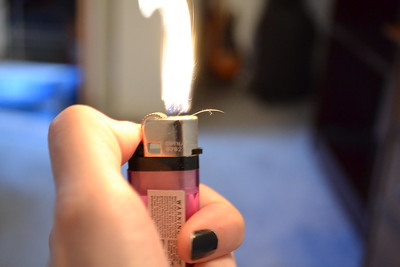
Yes, you can refill your butane lighter before it’s completely empty. In fact, topping it up before it’s fully drained can ensure you always have a reliable flame. Here’s how you can do it:
1.. Safety Comes First: Make sure you’re in a well-ventilated area, and keep away from any open flames or sources of ignition.
2. Purge Your Lighter: Before you fill it up, you’ll want to release any old butane and trapped air. This ensures a consistent flame after the refill.
- Hold your lighter with the refill valve facing up.
- Using a small tool (like a screwdriver or the stem of your butane can), press into the refill valve to release any remaining gas. You’ll hear a hissing sound, which is the gas escaping.
- Keep pressing until there’s no more gas coming out and the hissing stops.
3. Chill Your Lighter: This step isn’t mandatory, but placing your lighter in the freezer for a few minutes can help get a more complete fill. The cold contracts the gas, making the refill process smoother.
4. Time to Refill:
- Give your butane can a good shake.
- Align the stem of the butane can with your lighter’s refill valve.
- Press down firmly for a few seconds, filling the lighter. If you notice butane escaping around the valve, stop and adjust.
5. Let Your Lighter Rest: After the refill, give your lighter a few minutes to settle and return to room temperature.
6. Test It Out: Ignite your lighter. If you find the flame too high or too low, you can adjust it using your lighter’s built-in mechanism (if it has one).
Some Safety Precautions
Always remember to consult your lighter’s manufacturer’s instructions and be cautious during the refill process.
Before refilling your lighter, it’s necessary to bleed the lighter, which means releasing any remaining air and fuel from the lighter to avoid overfilling or pressure issues. Bleeding the lighter ensures that you are filling it with pure butane, rather than a mixture of air and butane. You can do this by pressing the fuel valve (usually located on the bottom of the lighter) using a small, flat-head screwdriver, a ballpoint pen, or a dedicated lighter bleeding tool. Hold the lighter away from your face and body while doing this, as the remaining fuel will be expelled.
Once you’ve bled the lighter, allow it to sit for a few minutes so it can reach room temperature. This helps ensure proper fuel flow when refilling. Before refilling, it’s essential to shake the butane canister well to make sure the fuel is adequately mixed. Then, hold the lighter upside down with the fuel valve facing up and align the nozzle of the butane canister with the fuel valve on the lighter.
Press the nozzle of the butane canister into the fuel valve firmly, creating a tight seal, and you will hear the sound of the fuel being transferred into the lighter. Be careful not to press too hard or force the nozzle, as this can damage the valve. The filling process usually takes a few seconds (typically 5-10 seconds), but the specific time can vary depending on the lighter’s size and the butane canister. Overfilling can cause the lighter to malfunction, so it’s crucial not to fill it for too long.
After filling the lighter, carefully remove the butane canister from the fuel valve and allow the lighter to sit for a few minutes. This lets the butane settle and reach room temperature, ensuring proper ignition and flame control when you use the lighter. Finally, test the lighter by igniting it away from your face and body. If the lighter doesn’t ignite or the flame seems weak, you may need to adjust the flame height using the flame adjustment mechanism (usually a small wheel or screw located near the fuel valve).
Here’s an article about Age Limit to Buy Butane.
| Items | Price |
|---|---|
 |
|
    |
|
    |
How do I know if my butane lighter is empty?
To determine if your butane lighter is empty or running low on fuel, look for the following signs:
- Weak or inconsistent flame: If your lighter produces a weak, inconsistent, or sputtering flame, it could be an indication that it’s low on fuel. As the butane level decreases, the flame may become less reliable and harder to maintain.
- Difficulty igniting: If you’re having trouble getting your lighter to ignite, it could be due to low fuel levels. When a lighter is almost empty, it may require several attempts before it successfully lights.
- No flame or hissing sound: If you try to ignite the lighter and it produces no flame or a hissing sound, it’s likely empty or very close to being empty. The hissing sound indicates that there is still some fuel left in the lighter, but not enough to create a flame.
- Lighter feels lighter: If you’re familiar with the weight of your butane lighter when it’s full, you may notice that it feels lighter when it’s empty. This change in weight can be an indication that it’s time to refill your lighter.
- Visual inspection: Some butane lighters have a clear fuel reservoir, allowing you to see the fuel level inside. If you can see that the reservoir is empty or nearly empty, it’s time for a refill.
It’s important to remember that a lighter’s performance can also be affected by factors other than fuel levels, such as air temperature, altitude, or mechanical issues. If you’re unsure whether your lighter is empty or experiencing other problems, consult the manufacturer’s instructions or contact the manufacturer for support.
Read related article: Why Do Lighters Use Butane Instead of Propane?
Know these issues when refilling lighters
Advantages of refilling a lighter before it’s empty
Ensuring consistent performance
By refilling your butane lighter before it’s empty, you can ensure consistent performance every time you use it. A partially-filled lighter may produce a weak or inconsistent flame, making it difficult to light candles, start a fire, or complete other tasks that require a reliable flame.
Avoiding malfunctions due to low fuel
A lighter that’s low on fuel is more prone to malfunctions or complete failure. By refilling your lighter before it’s empty, you can avoid these issues and keep your trusty tool working smoothly.
Convenience and preparedness
Refilling your lighter before it’s empty means you’ll always have a working lighter on hand when you need it. Whether you’re camping, hosting a barbecue, or just need to light a candle, you’ll be ready for anything.
Safety precautions when refilling a butane lighter
Working in a well-ventilated area
When refilling a butane lighter, it’s crucial to work in a well-ventilated area. This minimizes the risk of inhaling harmful butane fumes and reduces the chance of a fire hazard.
Using high-quality butane fuel
To ensure the longevity and optimal performance of your lighter, always use high-quality butane fuel. Lower-quality butane may contain impurities that can clog the lighter’s mechanism or even cause damage over time.
Following manufacturer’s instructions
Different lighters may have specific requirements or procedures for refilling. Always consult the manufacturer’s instructions for your particular lighter model to ensure you’re following the proper steps and using the appropriate butane fuel.
To learn the regulations, read this resource.
Steps to refill a butane lighter before it’s empty
Bleeding the lighter
Before refilling your butane lighter, it’s essential to bleed it, which involves releasing any remaining air and fuel from the lighter. This prevents overfilling or pressure issues and ensures that you’re filling the lighter with pure butane. To bleed the lighter, press the fuel valve (usually located on the bottom of the lighter) using a small, flat-head screwdriver, a ballpoint pen, or a dedicated lighter bleeding tool. Hold the
lighter away from your face and body while doing this, as the remaining fuel will be expelled. It’s crucial to take your time during this step, as proper bleeding ensures a smooth refill process and optimal performance afterward.
Allowing the lighter to reach room temperature
Once you’ve bled the lighter, let it sit for a few minutes to reach room temperature. This step is essential because it helps ensure proper fuel flow when you refill the lighter. Temperature fluctuations can affect the butane’s behavior, and allowing the lighter to reach room temperature ensures a more efficient refill process.
Shaking the butane canister
Before refilling your lighter, shake the butane canister well for about 10 seconds. This helps mix the fuel and any additives that may have settled, ensuring an even distribution of butane in your lighter for optimal performance.
Aligning and pressing the canister nozzle into the fuel valve
Hold the lighter upside down with the fuel valve facing up. Align the nozzle of the butane canister with the fuel valve on the lighter. This positioning ensures that the fuel is transferred efficiently and without any leakage.
Filling the lighter for the appropriate amount of time
Press the nozzle of the butane canister into the fuel valve firmly, creating a tight seal. You will hear the sound of the fuel being transferred into the lighter. Be careful not to press too hard or force the nozzle, as this can damage the valve.
The filling process typically takes about 5-10 seconds, depending on the lighter’s size and the butane canister. However, the specific time may vary, so it’s essential to monitor the process and avoid overfilling, which can cause the lighter to malfunction or leak.
Removing the butane canister and letting the lighter rest
After filling the lighter, carefully remove the butane canister from the fuel valve. Once the canister is detached, allow the lighter to sit for a few minutes. This lets the butane settle and reach room temperature, ensuring proper ignition and flame control when you use the lighter.
Testing and adjusting the lighter if necessary
Finally, test the lighter by igniting it away from your face and body. If the lighter doesn’t ignite or the flame seems weak, you may need to adjust the flame height using the flame adjustment mechanism (usually a small wheel or screw located near the fuel valve). Adjust the flame to your desired height and test again to ensure the lighter is functioning correctly.
Conclusion
Refilling a butane lighter before it’s completely empty is not only possible but also advantageous. By following the proper procedure and safety precautions, you can ensure consistent performance, avoid malfunctions, and always be prepared with a working lighter when you need it.
Remember, the key to successful lighter refilling lies in adhering to the manufacturer’s guidelines for your specific lighter model, working in a well-ventilated area, using high-quality butane fuel, and carefully following each step of the process. With a bit of practice, you’ll become a lighter-refilling pro in no time!
So, the next time you’re tempted to toss an almost-empty lighter, remember that you can refill it and give it a new lease on life. Don’t forget to share this article with friends and family who might also benefit from this valuable knowledge. Happy refilling!


Mike is an experienced propane technician with over 15 years of professional experience in the field. He has dedicated his career to helping customers with their propane needs, from installation to maintenance and repair. Together with Jeremy, he co-founded this website to provide useful information and guidance to customers seeking reliable propane services.






